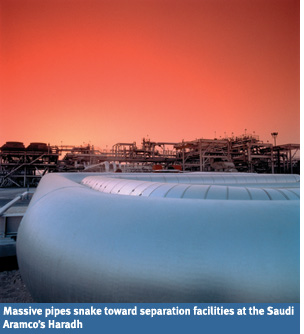We can do the job, says Saudi Aramco
Company has the reserves, technical ability and project know-how
King Abdullah’s recent trip to China and India, reported in last month’s Pipeline, will expand relations in all fields between Saudi Arabia and the two Asian giants, says the Saudi Aramco chief.
 Abdallah S. Jum’ah, President and CEO, said the world’s oil superpower is keen to meet the crude oil needs of all countries, particularly the developing economies of China and India. Abdallah S. Jum’ah, President and CEO, said the world’s oil superpower is keen to meet the crude oil needs of all countries, particularly the developing economies of China and India.
Speaking in Davos, Switzerland, last month he said Saudi Aramco was pushing ahead with expansion projects to boost crude supplies and maintain its position as the world’s top crude supplier.
“Saudi Aramco has a two-pronged strategy of meeting the needs of nations that are already large oil consumers while paying attention to the growing needs of developing nations, especially India and China,” Jum’ah said.
Responding to worries about depletion of oil reservoirs around the world, Jum’ah said there were plenty of energy resources available, including oil. He said one of the most important points is for the world to increase its efforts to achieve peace and stability in the Middle East, which holds the majority of oil resources.
Jum’ah also expressed his confidence in Saudi Aramco and its contractor partners. “Saudi Aramco has repeatedly demonstrated its ability to expand capacity,” he said. “In fact, we have always delivered what we said we would. We have the oil reserves, necessary technical abilities, and the project know-how, including contractor resources, to do the job.”
The company is currently expanding its production, processing and transport infrastructure to allow for 12 million barrels per day capacity which includes a commitment to maintain 1.5 million to two million barrels per day of spare production capacity.
Saudi Aramco’s Qatif project, north of Dhahran, was inaugurated over a year ago. This has increased production capacity by 800,000 barrels per day. Some 500,000 barrels derives from onshore extraction and 300,000 barrels from the offshore Abu Safah field which is part of the Qatif production project.
Increased production capacity has been helped by completion of other recent projects in the South Riyadh oilfield, Shaybah, as well as Qatif.
A project in the Haradh field to produce another 300,000 barrels a day will be completed this year while 500,000 barrels a day is expected to come onstream from field developments at Abu Hadriya, Fadhili and Khursaniyah in 2007.
New production at the Khurais field north of Saudi Aramco’s principal Ghawar field will increase output there to 1.9 million barrels a day by 2009.
Saudi Aramco has a conservative approach to reservoir estimates and depletes its reserves at a far slower rate than major oil companies – a policy designed to provide a healthy cushion between production and maximum sustainable capacity.
Dr Nansen Saleri, Saudi Aramco’s oil reservoir manager, said that Saudi Aramco’s production capacity can easily be increased to sustainable rates of 12 million to 15 million barrels a day if global markets demand the extra crude.
With 27.62 per cent of the world’s proven oil reserves, Saudi Arabia possesses the lion’s share of all crude. About 130 billion barrels of this is developed and mostly in production.
Saudi Aramco’s plans call for the replacement of 15 billion barrels of reserves between 2005 and 2009 at a rate of about three billion barrels a year.
“We believe very confidently that we are looking very conservatively upwards of 150 billion barrels over and above the 260 billion barrels that we carry as proven reserves right now. That is 60 per cent more and that’s the underlying message we want to convey,” Dr Saleri told the Centre for Strategic and International Studies.
Saudi Aramco considers that the huge acreage in Saudi Arabia’s Rub al-Khali Empty Quarter desert region offers big potential for new oil finds as well as the northern basin towards the northern border as well as the Red Sea basin.
|



